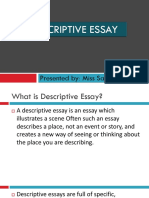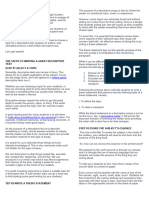0% found this document useful (0 votes)
47 views2 pagesPlanning:: Descriptive Writing
The document provides steps for writing a descriptive piece, including selecting a topic, creating an introductory statement, using language that engages the five senses and figurative devices, organizing the body paragraphs, and concluding with a final review. It also discusses descriptive writing styles, planning considerations like the subject and purpose, and drafting techniques such as metaphors, similes, and personification. Revising involves ensuring enough detail and organization to convey a vivid perception, using precise vocabulary and paragraphs structured around a clear main idea.
Uploaded by
salibindla jyothiCopyright
© © All Rights Reserved
We take content rights seriously. If you suspect this is your content, claim it here.
Available Formats
Download as DOCX, PDF, TXT or read online on Scribd
0% found this document useful (0 votes)
47 views2 pagesPlanning:: Descriptive Writing
The document provides steps for writing a descriptive piece, including selecting a topic, creating an introductory statement, using language that engages the five senses and figurative devices, organizing the body paragraphs, and concluding with a final review. It also discusses descriptive writing styles, planning considerations like the subject and purpose, and drafting techniques such as metaphors, similes, and personification. Revising involves ensuring enough detail and organization to convey a vivid perception, using precise vocabulary and paragraphs structured around a clear main idea.
Uploaded by
salibindla jyothiCopyright
© © All Rights Reserved
We take content rights seriously. If you suspect this is your content, claim it here.
Available Formats
Download as DOCX, PDF, TXT or read online on Scribd
/ 2






















































